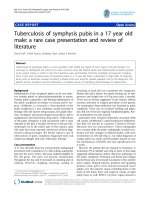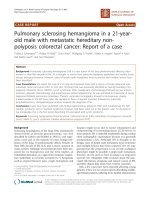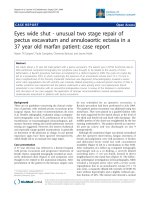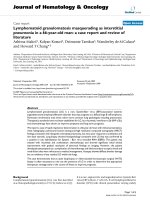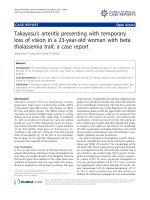Successful management of Russel’s Viper snake envenomation in a female dog
Bạn đang xem bản rút gọn của tài liệu. Xem và tải ngay bản đầy đủ của tài liệu tại đây (258.89 KB, 3 trang )
Int.J.Curr.Microbiol.App.Sci (2019) 8(6): 39-41
International Journal of Current Microbiology and Applied Sciences
ISSN: 2319-7706 Volume 8 Number 06 (2019)
Journal homepage:
Case Study
/>
Successful Management of Russel’s Viper Snake
Envenomation in a Female Dog
S. Vijayakumar1*, S. Sivaseelan2 and K. Dhandapani3
1
Department of Animal Husbandry, Erode, Tamil Nadu, India
University Training Research Centre, Dindigul, Tamil Nadu, India
3
Department of Veterinary Parasitology, Veterinary College and Research Institute,
Thirunelveli, Tamil Nadu, India
2
*Corresponding author
ABSTRACT
Keywords
Russell’s viper,
German shepherd
crossbred dog,
Snakebite, Blood
Clotting time,
Treatment
Article Info
Accepted:
04 May 2019
Available Online:
10 June 2019
A six year old female German shepherd crossbred dog was reported with the
history of snake bite by Russell’s viper, acute onset of oozing of blood from inner
side of the oral cavity, oedematous face, congested conjunctival mucus membrane,
restlessness and respiratory distress and signs of disseminated intravascular
coagulation. Animal was treated with Polyvalent Snake Venom followed by
supportive therapy of Tetanus Toxoid, Dexamethasone, Atropine Sulphate, and
antibiotic combinations like ceftriaxone and metronidazole along with liver tonic.
Whole Blood Clotting time took more than 20 minutes after the administration of
first dose, a second dose was administered. Animal made an uneventful recovery
after 5 days. Successful therapeutic management of snake envenomation in a
German shepherd crossbred dog is presented.
severe in small animals as compared to large
animals. The severity of the bites in animals
depends upon the type of snake, age of the
animal, size of the animal, number of bites
and the amount of venom injected. Snake bite
with envenomation is an emergency, which
needs rapid examination and proper treatment
Vijayakumar et al., (2001) or otherwise
delayed and inadequate treatment may lead to
untoward consequences. The present paper
deals with a case of Russell’s viper (Daboia
Introduction
In the Indian subcontinent, out of about 216
species of snakes documented, 52 are
considered to be poisonous and the common
venomous snakes encountered are Cobra,
King Cobra, Russell’s viper, Saw Scaled
Viper and Krait. Snake bites in domestic
animals occur more common in dogs and
horses compared to cattle, sheep and goat
Garg (2000). The clinical effects are more
39
Int.J.Curr.Microbiol.App.Sci (2019) 8(6): 39-41
russelii) snake bite in a dog and its successful
therapeutic management.
Toxoid 0.5 ml i/m. The antibiotic therapy was
continued for three days with Ceftriaxone@
25 mg/kg i/v and Metronidazole @ 5 mg/kg
i/v along with the liver tonic.
Case history and clinical observations
A 6 years old female German shepherd
crossbred dog weighing 16 Kg was presented
to
the
Veterinary
Dispensary,
A.
Puthupalayam, Erode, and Tamil Nadu with
the history of Russell’s viper snake bite.
Results and Discussion
Snake venoms are composite mixture of many
enzymes, proteins and peptide compounds.
The Rusell’s viper venom is majorly
haemotoxic but also neurotoxic. According to
Segev et al., (2004), venom-induced
thrombocytopenia is frequently observed in
animals and people with moderate to severe
viper envenomation. Possible mechanisms
leading to thrombocytopenia in viper
envenomation
include
vasculitis,
sequestration of platelets in inflamed tissue,
and consumption of platelets with potential
development of disseminated intravascular
coagulation (DIC). According to Klaassen
(2008), hyalurinadase cleaves internal
glycoside
bonds
in
certain
acid
mucopolysaccharides resulting in decreased
viscosity of connective tissues allowing other
fractions of venom to penetrate the tissues.
The cyanotic edema observed at the site of
bite may be attributed to enzyme
hyaluronidase which acts as a spreading
factor.
Physical examination of the animal revealed
oozing of blood from bitten areas (inner side
of the oral cavity and left inner lips) (Fig. 1),
oedematous face, congested conjunctival
mucus membrane, restlessness and respiratory
distress. The clinical parameters viz., rectal
temperature, respiration and heart rates were
recorded
following
standard
clinical
examination methods Kelly (1984).
Whole blood was collected and tested for
twenty minutes to assess the clotting time.
Based on the history and fang-marks on the
body, it was diagnosed as Russell viper snake
bite and was treated with 10 ml of Polyvalent
Snake Venom slowly administered along with
the 500 ml of DNS (Dextrose Normal Saline)
intravenously followed by supportive therapy
of Dexamethasone @ 2 mg/kg i/v, Atropine
Sulphate @ 0.04 mg/kg i/m, and Tetanus
Fig.1 Oozing of blood from inside the oral cavity and inner lips
40
Int.J.Curr.Microbiol.App.Sci (2019) 8(6): 39-41
The swelling and necrosis at the site of bite is
majorly because of proteolytic enzymes,
collagenase, Phospholipase A2, and 5'
Nucleotidase etc., Garg (2000). The bleeding
from the wound suggested the effect of
venom interference in many components of
haemostatic system (Wolff, 2006). Sometimes
lyophilized polyvalent anti-snake venom may
cause anaphylactic reactions Sai et al., (2008)
and to overcome this untoward effect to
antivenom, dexamethasone injection was
given to the dogs. Atropine sulphate is given
to prevent the undesirable muscarinic effects
of acetylcholine such as increased secretions,
bradycardia and colic. Prophylactically,
Shukla
(2009)
suggested
that
the
administration of tetanus toxoid provides
protection against the tetanus spore that might
have entered animal body from contaminated
snake mouth and broad spectrum antibiotic
were administered to the dogs, as the fangs of
the snake are supposed to be contaminated
with various types of bacteria. The treatment
of present case with various drugs is in
accordance with Singh (2015). Also the
twenty minute clotting time of whole blood
plays an important role in determining the
administration of Polyvalent Snake Venom
Antiserum. If failure to clot by 20 minutes
indicated that case requires repeated
administration of Polyvalent Snake Venom
Antiserum. In this present case, since the
blood clotting took more than 20 minutes
after the administration of first dose, a second
dose was administered.
References
Garg, SK., 2002. In Zootoxins. Veterinary
Toxicology, CBS publishers and
Distributers 1st Edn New Delhi.
Kelly, W.R., 1984. Veterinary Clinical
Diagnosis [Bailliere Trndall, London,
3th edn].
Klaassen, C.D., 2008. Properties and
Toxicities
of
animal
Venoms.
Toxicology. 7th Edn, McGraw-Hill,
New Delhi. Pp. 1093-1098.
Sai, M., Satish, K., and Thirumala, RS. 2008.
Therapeutic management of snake bite
in a dog. Intas Polivet. 9:116-118.
Segev, G., Shipov, A., Klement, E., Harrus,
S., Kass, P. and Aroch, I. (2004).Vipera
palaestinae envenomation in 327 dogs:
a retrospective cohort study and
analysis of risk factors for mortality.
Toxicon. 43: 691-99.
Shukla, PC., 2009. Snake bite in animals and
its treatment. Pashudhan.; 35(2): 2-4.
Singh, T., 2015. Clinical Management of
Snake Bite in a Dog. Intas Polivet.
16(1):138-139.
Vijayakumar,
G.,S.G.
Kavita,
K.
Krishnakumar, P.S. Thirunavukkerasu
and Subramanian, M. 2001. Snake
envenomation in dog- A case report.
Indian Vet J.; 78: 1146-1149.
Wolff, F.A.D., 2006. Natural Toxins. In:
Clarke’s Analysis of Drugs and Poison.
Pharmaceutical
press,
London,
Electronic Version.
How to cite this article:
Vijayakumar, S., S. Sivaseelan and Dhandapani, K. 2019. Successful Management of Russel’s
Viper Snake Envenomation in a Female Dog. Int.J.Curr.Microbiol.App.Sci. 8(06): 39-41.
doi: />
41
